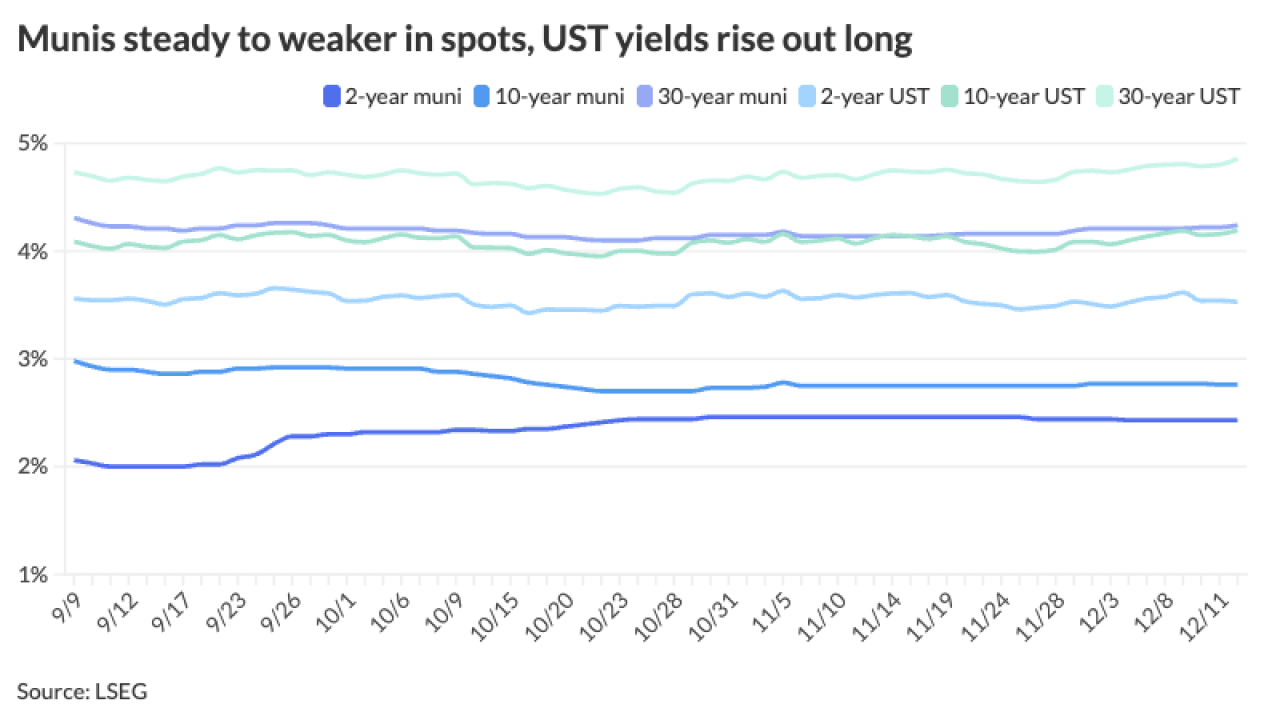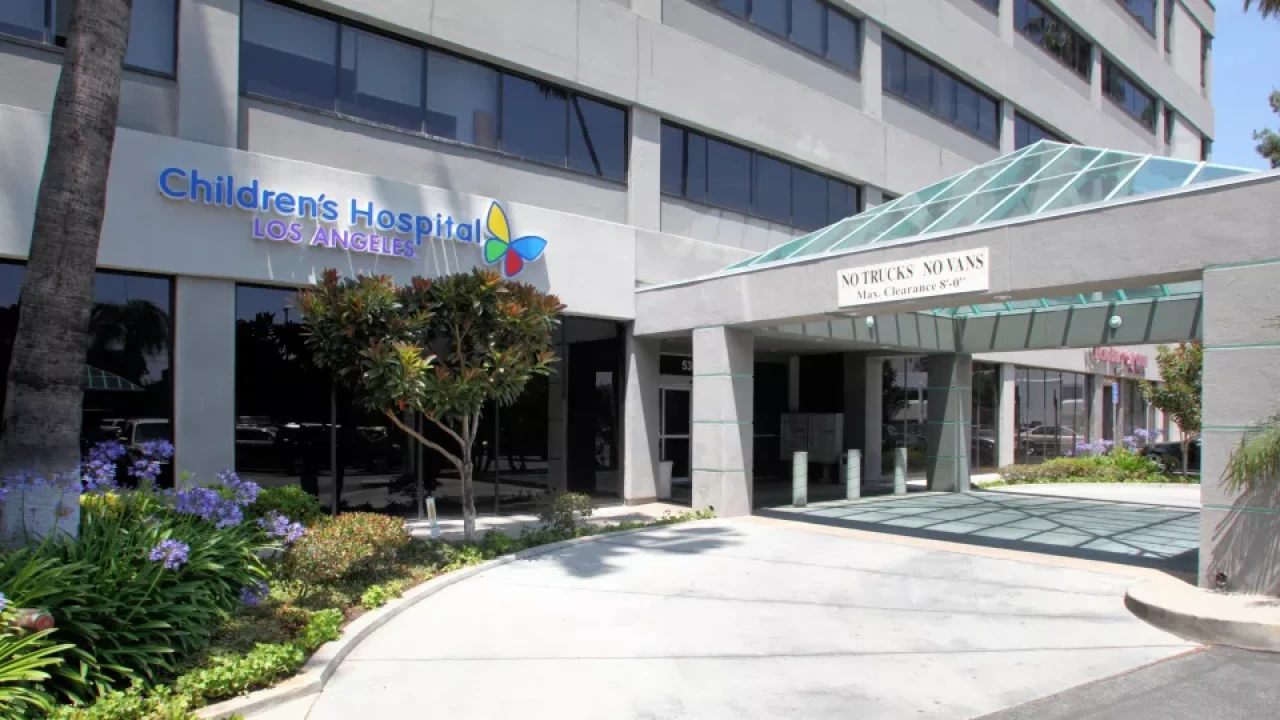Municipals started May firmer as inflows returned after seven weeks of outflows, while U.S. Treasury yields rose and equities ended higher.
The two-year ratio Thursday was at 78%, the five-year at 78%, the 10-year at 78% and the 30-year at 92%, according to Municipal Market Data's 3 p.m. ET read. ICE Data Services had the two-year at 79%, the five-year at 79%, the 10-year at 78% and the 30-year at 93% at 4 p.m.
Investors added $1.567 billion to municipal bond mutual funds in the week ended Wednesday, following $397.4 million of outflows the prior week, according to LSEG Lipper data. This is the largest inflow figure since January.
High-yield funds saw inflows of $234 million compared to the previous week's outflows of $142.2 million.
Municipals saw losses in April. The asset class saw returns of -0.81% for the month and -1.03% for the year.
High-yield munis saw -1.78% for April and -0.98% so far this year, while taxable munis saw losses of 0.08% last month but are +2.91% YTD.
USTs posted gains of +0.63% for the month and +3.57% for the year to date, while corporates were little changed in April at -0.03% but returned +2.27% during the first four months of the year.
Following a volatile April, a few municipal bond analysts are optimistic about the near-term future.
"Under ordinary circumstances, April is a challenging month for municipal market performance, due to seasonal factors — tax-related selling, low monthly reinvestment demand, and heightened new-issue supply," J. Robert Lind, principal and founder of Lind Capital Partners, writes in the firm's monthly market commentary.
"Looking back, months or years from now, April 2025 will be defined by the historic volatility triggered by President Trump's 'Liberation Day' tariff announcement on April 2. Looking ahead, May, June and July will bring significant coupon reinvestment (demand) back to the market. New issue supply should abate as we enter the summer months," he said.
"Combined, these should start to provide some market stability going forward, as we are already seeing that in the investment-grade world," he said.
"The dislocation today provides long-term investors the opportunity to exploit the current market dislocation and construct tax-exempt portfolios that should generate high levels of tax-exempt income for many years to come," Lind said. "It has been a long time coming, but it seems the market opportunity is finally here."
With munis an area of opportunity amidst the uncertainty, yields are at very attractive levels relative to alternatives — due to technical factors and not concerns over credit quality — and they will likely remain that way for the near future due to a large influx of supply this week," said Cooper Howard, a fixed income strategist at Charles Schwab.
This flood of issuance, some of which was accelerated to price before April's close, led to the month's
José Torres, a senior economist at Interactive Brokers, sees a "light at the end of the tunnel" following "well-received big-tech earnings and the White House reporting trade deal progress with major allies, including South Korea, Japan and India."
In addition, investors "can increasingly look forward to a Fed cut or two in response to the third day in a row of softer-than-expected labor market data," culminating in Thursday's initial jobless claims, which "hit their highest level in over three years," while "economists and traders alike are indeed wondering if [Friday's] nonfarm payrolls will also disappoint," Torres said.
Nevertheless, "weaker figures in the short term are likely a result of the elevated uncertainty from the Trump presidency's first 100 days and can reverse strongly against the backdrop of policy achievements from the Oval Office coinciding with a looser Federal Reserve," Torres said.
"Indeed, investors have taxation relief, trade deals, rate cuts, lighter regulations, subdued energy costs, onshoring initiatives and the increasingly positive aspects of the Trump policy mix to be enthusiastic about in the coming months," he said. "The contraction to begin the year was nothing more than a mid-cycle adjustment amidst Trump bumps."
"For investors in the highest marginal tax bracket, tax-exempt municipal bonds offer especially attractive tax-equivalent yields of 6.5%," David Hagee, chief investment officer at Commerce Trust, writes in the firm's second quarter "Look at the Markets" report.
"Core investment-grade taxable bond sectors are producing 4-5% yields, which look appealing compared to the last decade," he said.
Additionally, "fixed income investments outside of the investment grade universe offer opportunities to capture additional yield," Hagee said.
"While rates are volatile day-to-day, the 30-day average has remained fairly consistent," Hagee added. "Yields have moved in a range of plus or minus 75 basis points (bps) but remain at attractive levels."
Primary market
The largest deal Thursday was the Los Angeles Department of Water and Power (Aa2//AA-/AA/) with an almost $1 billion transaction.
Barclays priced for LADWP $991.1 million of power system revenue bonds, 2025 Series A, with 5s of 7/2028 at 3.74%, 5s of 2030 at 3.80%, 5s of 2035 at 3.81%, 5s of 2040 at 4.24%, 5.25s of 2045 at 4.57%, 5s of 2050 at 4.90% and 5s of 2055 at 4.80%, callable 1/1/2028.
Also in the new-issue market, BofA Securities priced $400 million of Tulsa Municipal Airport Trust revenue bonds, Series 2025 for the American Airlines, Inc. Project (//B+/). The bonds are subject to the alternative minimum tax.
The issue included $300 million term bonds due 12/2035 priced as 6.25s to yield 5.19% and $100 million term bonds due 12/2040 as 6.25s to yield 5.41%.
J.P. Morgan Securities priced $196 million Series 2025 senior airport facilities revenue bonds (BBB-plus+) for Transportation Infrastructure Properties, LLC ("Trips") Obligated Group through the Build NYC Resource Corp (nonrated). The issue included 5.5s of 7/2041 priced to yield 4.75%, 5.5s of 7/2045 at 4.95%, 5.5s of 7/2050 at 5.00% and 5.5s of 2/2055 at 5.05%.
Piper Sandler & Co. priced $195.575 million healthcare facilities revenue refunding bonds (HealthPartners Obligated Group), Series 2025 for the Saint Paul Housing and Redevelopment Authority, Minnesota (A2/A//). The issue included 5s of 7/2025 priced to yield 3.60%, 5s of 7/2030 at 3.6%, and 5s of 7/2033 at 3.80%.
Goldman Sachs priced $150 million of Series 2025A Massachusetts Development Finance Agency revenue bonds for Amherst College (Aaa/AA+//). The bonds were priced as 5s to yield 3.64% in 11/2055.
AAA scales
MMD's scale was bumped: The one-year was at 2.86% (-3bp, no May roll) and 2.89% (-3bp, no May roll) in two years. The five-year was at 2.97% (-5bp, no May roll), the 10-year at 3.29% (-6bp, +1bp May roll) and the 30-year at 4.36% (-2) at 3 p.m.
The ICE AAA yield curve was bumped up to two basis points: 2.85% (-2) in 2026 and 2.86% (-2) in 2027. The five-year was at 2.96% (-2), the 10-year was at 3.27% (-2) and the 30-year was at 4.36% (unch) at 4 p.m.
The S&P Global Market Intelligence municipal curve was bumped three to five basis points: The one-year was at 2.86% (-3) in 2025 and 2.89% (-3) in 2026. The five-year was at 2.97% (-5), the 10-year was at 3.29% (5) and the 30-year yield was at 4.35% (-3) at 4 p.m.
Bloomberg BVAL was bumped two to four basis points: 2.82% (-2) in 2025 and 2.88% (-2) in 2026. The five-year at 3.00% (-3), the 10-year at 3.31% (-3) and the 30-year at 4.36% (-2) at 4 p.m.
Treasuries were weaker.
The two-year UST was yielding 3.705% (+10), the three-year was at 3.689% (+9), the five-year at 3.% (+8), the 10-year at 4.238% (+7), the 20-year at 4.748% (+5) and the 30-year at 4.734% (+6) near the close.
Jessica Lerner contributed to this story.





